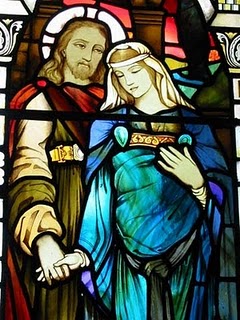
The women in the canonical New Testament are often relegated to feminine stereotypes such as mother (the Virgin Mary), temptress (Salome), and prostitute (Mary Magdalene) the placid, doe-eyed nurturer, the lusty, bloodthirsty dancer, or the obsequious, prostrate whore. Yet if conservative theologians are mistaken in their opposition to an open canon and continuous revelation, we may be unearthing evidence supporting the position that the greatest apostle of all was Mary Magdalene herself.
The role of Mary Magdalene in the early Christian movement has been the topic of both historical research and fiction. In an excerpt from his book The Gospels of Mary: The Secret Tradition of Mary Magdalene which appeared in a recent special issue of U.S. News & World Report, religious scholar Marvin Meyer takes the approach that the apocryphal Gnostic gospels provide as much insight into the truth surrounding the historical (or at least legendary) Mary of Magdala as does the accepted canon.
Meyer gives several reasons for treating Mary not as a servile, repentant prostitute who tags along after the men (as portrayed in the Bible), nor even as an equal with the other disciples, but rather as Jesus's favorite apostle of all and one who has truly grasped the mysteries of her mentor's teachings. She is one of at least three women who form a part of Jesus's following, travelling with him in their own right, independent of any husband, family member, or other chaperon and without any male intermediary serving to interpret for them the teachings of Christ. In addition, Meyer claims, texts such as the Gospel of Mary, the Gospel of Thomas, the Gospel of Philip, the Dialogue of the Savior, and the Pistis Sophia all portray Jesus associating equally with women and men. In these early literary sources, moreover, Mary serves as an "articulate advocate for the gospel" and "an eloquent leader of the faith" who emboldens the male disciples upon Jesus's departure, assuring them of his protection and encouraging them to have confidence in themselves and in his teachings. She seems to show the greatest ability to comprehend the mystical quality of spiritual liberation encoded in Jesus's teachings when, in the Gospel of Mary, she recounts for the other disciples a vision she had of the soul's journey toward its fate, despite the contentions of Peter and Andrew with the authority of a woman's insight. In Pistis Sophia, she is described as the most important disciple and interprets the teachings of Jesus and scripture for her peers, explaining for them the nature and quality of salvation; Jesus tells her, "[y]ou are one whose heart is set on heaven's kingdom more than all your brothers". Finally, when Mary finds the risen Jesus outside his tomb and reports his Resurrection to the others, she becomes known as the apostle to the Apostles. Certainly a respectable curriculum vitae by anyone's standards.
But perhaps most controversial of all is the claim that this seemingly strong, independent, and single-mindedly devoted woman may have been the literal bride of Christ, who sired at least two of her children. Many who are familiar with this theme from popular historical fiction and Hollywood movies such as The Da Vinci Code will roll their eyes at this notion as a farfetched, romantic myth, but at least one early text suggests this relationship between Mary and Jesus. In the Gospel of Philip, notes Meyer, it is said not only that Jesus loves Mary more than any other disciple, but also that he kissed her frequently, and that she was his partner, companion, and consort; meanwhile, religious studies professor James Tabor argues that Jesus intended not to establish a new religion centered on his divinity, but rather to set up a dynasty and a new kingdom based on his descent from King David. If Mary was in fact Jesus's consort, this would have made her not just a wise mystic, but a queen. If we are not to take it for granted that divine revelation began and ended with the compilation of the canonical Bible some time in the fourth century, it would behove us to consider the theories based on these texts more closely.
If Meyer's view of Mary is legitimate and the Gnostic gospels constitute a part of the Christian revelation, it would seem that we have been duped by the Church for centuries, and that it has led us to reduce a mystical adept to a brown-nosing prostitute. This would explain why in the Dialogue of the Savior, as Meyer argues, teachings uttered by Mary are attributed elsewhere to Jesus: it may have been too much for the young Church to attribute such spiritual insight to a mere woman. Meanwhile, the Gospel of Mary and other apocrypha remain important works in the tradition of Gnosticism. It is a complex, esoteric question that requires much further exegesis and textual comparison, but if we ever solve the mystery of Mary's identity, it may change everything we have assumed about the spiritual authority of women in Christianity and the crucial contributions of these women to the original elements of Christian theology.
Read more about the history of Christianity in our Guide to Divinity.


This is the most beautiful thing Ive read in a long time. I agree with it whole heartedly. I believe that Mary is the woman who holds the heart of Jesus (AKA: Archangel Uriel). She is Goddess of the Moon. She is the persistent balance to his patience. She is his queen, his lover, and he is her best friend, her lord, her guide. Two hearts that can never be severed, strengthened through time, bonded by suffering. She is his lion, his rose, his reflection. Perfectly imperfect.